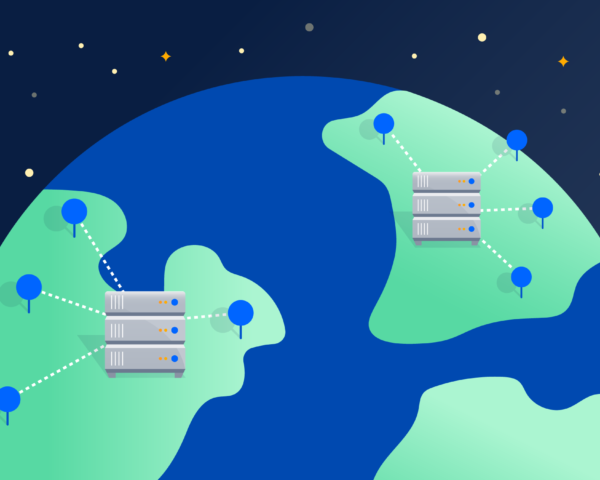Supporting distributed teams with Bitbucket Data Center
Here are the signs your team might be ready for an upgrade.
It’s been almost ten years since entrepreneur and investor Marc Andreessen wrote the essay, “Why Software is Eating the World,” examining the transformation of traditional industries into software-driven companies. This new economy forced a shift in the organizational paradigm that companies should be built to last to the need for them to be built for change. And that has never been more true than it is today. As we all continue to settle into our new reality of remote work, organizations are doing what they can to respond, evolve, and learn how to keep work moving. This requires software that is reliable and performant to ensure that teams can continue to deliver high-quality products and services to your customers.
The good news is that many developers have experienced remote work in the past and are accustomed to using online collaboration tools. What’s changed is every team’s complete reliance on these tools to get their work done; any interruption or degradation in performance is now exponentially harder to overcome. So organizations that consider Bitbucket essential may benefit from the reliability and performance tools available in Bitbucket Data Center. Our enterprise-grade edition of Bitbucket provides access to features that better support a distributed workforce and prevent performance degradation and downtime. Here are three common signs that it may be worth considering a move to Bitbucket Data Center:
1. Your teams depend on Bitbucket to do their work
As the realities of a remote workforce set in, the reliability and stability of your application become paramount to ensuring that there’s little impact on productivity. Developers are no longer just dealing with the pressures of delivering high-quality work; they’re tackling new routines, new work environments, and new personal obligations. So any added interruptions caused by rogue scripts, increased usage, or infrastructure challenges not only slow work down, but can stop work altogether. To address those challenges, Bitbucket Data Center offers high availability and active clustering to ensure users have uninterrupted access to their application. Active clustering allows you to configure your setup so that you can direct traffic to specific nodes based on activity or add more active nodes to offset demand during peak times. If a node fails, the load balancer will automatically redirect users to another active node in the pool or cluster. With Data Center, you benefit from access to a level of reliability and control that is not available on our server solution.
Another feature that protects the integrity of your instance is rate-limiting. This gives admins the tools to identify, respond, and prevent bad actors from flooding your REST API. So whether it’s a poorly written script or an app sending lots of unnecessary requests, rate-limiting uses a token bucket algorithm to create defined limits for each user and prevent them from overloading the system. Rate-limiting paired with setting an upper limit on the maximum number of SSH connections provides a layer of self-protection that will keep your instance humming smoothly and your teams on track.
Beyond the safeguards we have in place for your instance, Data Center also offers support for issues created by third-party plugins. If you’re familiar with the Atlassian Marketplace, you’ve seen how apps and plugins can extend the utility of Bitbucket and allow teams to customize how they interact with Atlassian products. Unfortunately, when these apps fail, the effects can spill over and impact your entire instance. To help surface those issues and ensure teams can quickly respond to them, we’ve built the Atlassian diagnostics plugin, which allows admins to get a quick overview of the health of their system and detect if there are any stability issues, keeping your instance and everything supporting it in tip-top shape.
2. Your admins would benefit from additional tools
A significant drawback of unplanned remote work is the additional administrative overhead it creates. From balancing new processes to managing applications that are being stretched to their limits, admins are on the front lines of ensuring that software continues to move work forward. Ensuring that they have the right tools to be successful not only improves their quality of life but scales the success of all the teams they support. In Bitbucket Data Center, those tools kick in right away. We offer Quickstart templates for AWS and Azure that streamline the upgrade process, improve performance, and help consolidate multiple server instances into a single Data Center instance. Data Center also simplifies user management by incorporating identity management seamlessly and securely with support for SAML 2.0 and OpenID Connect. So whether you’re onboarding a new user remotely or upgrading your system’s compliance protocols to address this new reality, these tools offer enterprises a frictionless way to authenticate their users.
3. Your distributed teams are experiencing performance degradation
As so much has become unpredictable, ensuring your teams have a consistent experience and performance that helps their productivity flourish can be a daunting task. Maybe you need to scale up a new project or pivot strategy because conditions have changed. Whatever this new environment means for your team, Data Center has the tools to minimize performance degradations caused by a distributed workforce. To improve Git clone speeds for teams working with large repositories, we offer Smart Mirrors – live mirror nodes that operate with read-only copies of repositories in remote locations. Remote teams can make requests from the mirror nodes rather than having to request the primary node, significantly reducing the time it takes to get their work done. And for even larger teams that experience degraded performance or congestion due to CI builds, we offer Smart Mirror Farms, which give the ability to cluster mirrors behind a load balancer to reduce time spent waiting for those builds. So whether your teams are in Sydney or Gdansk, Data Center can reduce the time spent waiting and improve geo-performance.
In addition to Smart Mirrors, Data Center also includes delta islands, which can improve the performance of clone and fetch operations, in some cases cutting wait time in half for large repositories.
These were just a few examples of how Bitbucket Data Center can support your organization as it moves through this period of uncertainty. If you’d like to learn more about how to upgrade to Data Center, here are our resources. You can also try these services for free, with a 30 day trial of Bitbucket Data Center. Check out this blog to learn how to upgrade to Data Center in just minutes.



